Affiliate disclosure: This post may contain affiliate links. Please see our Privacy Policy.
Black walnut tincture is an astringent, tannic, and cleansing herbal remedy for the digestive system and body. It’s often used to treat fungal, bacterial, and parasitic infections. In herbal tradition, it is also used to treat thyroid disorders. This helpful remedy is easy to make at home and uses the green hulls that would normally be a waste product from black walnuts.
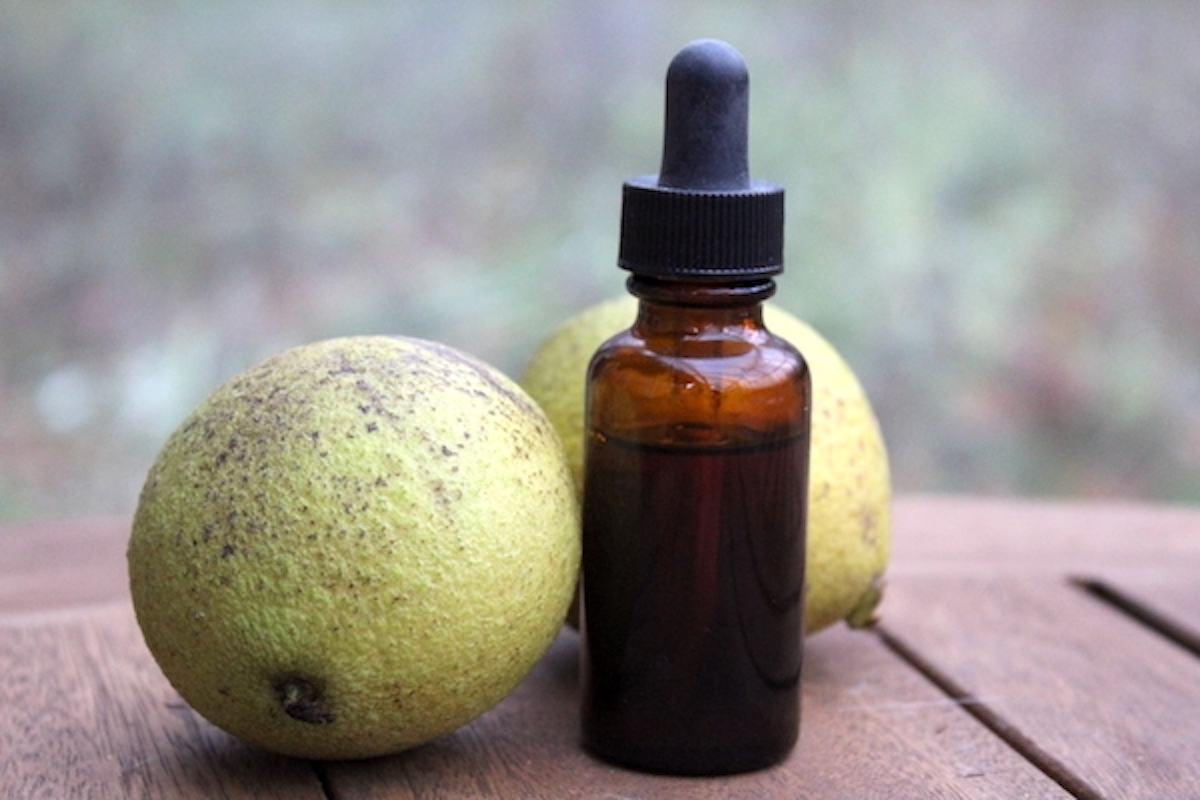
Bitter and astringent, black walnut tincture can help clear the body and digestive system of lingering infections.
Its high levels of tannins contribute to its bitter flavor and probably to its antibacterial, anti-fungal, and anti-parasitic properties. When you’re struggling to fight off an illness, black walnut tincture can provide support.
These stately cold hardy nut trees grow throughout the eastern and central United States. They’re most common in areas of well-drained bottomland with neutral soil, but they’ll tolerate other conditions, too.
Black walnuts are sometimes grown as shade trees, though they’re crop of walnuts can have made them less choice for urban designers than other species. While some value the nuts, others just think of them as a messy nusance dropped each autumn.
The nuts are hard to crack, but not bad if you know the trick to cracking black walnuts. You can also use the unripe green black walnuts in all manner of traditional recipes (from liqueur to jam).
Wild Black walnuts are fairly easy foragers to spot. They have 1 to 2-foot-long pinnately compound bright green leaves and deeply furrowed gray-black bark. Their nuts, which ripen and fall in late summer or autumn, are covered in a green husk that eventually turns brown.
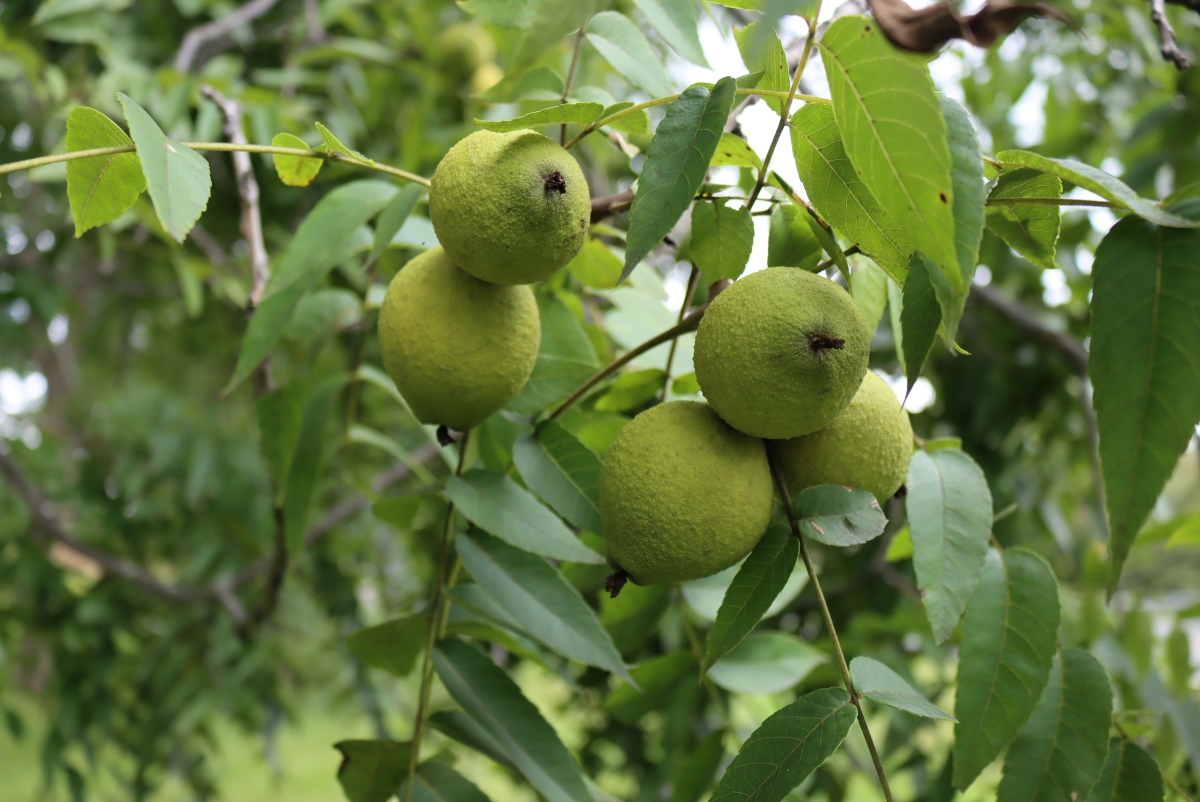
If you’d like to grow one, there’s a lot to love about these native trees. The nuts can be used for food, medicine, and natural dye. They provide shade, sometimes reaching 80 feet tall, and are an important habitat for native wildlife and insects. They also have beautiful dark brown hardwood.
As they’re a native species, you can usually find affordable black walnuts through organizations like the Arbor Day Foundation.
These easy-going trees can be planted nearly anywhere and will tolerate acidic, alkaline, clay, loamy, moist, rich, sandy, well-drained, and wet soils in USDA hardiness zones 4 through 9.
They produce a compound called juglone, which prevents most other plants from growing beneath them and eliminates competition for nutrients and space.
Keep in mind that newly planted trees may take up to 7 years to bear nuts. So, in the meantime, you’ll have to stick to foraging.
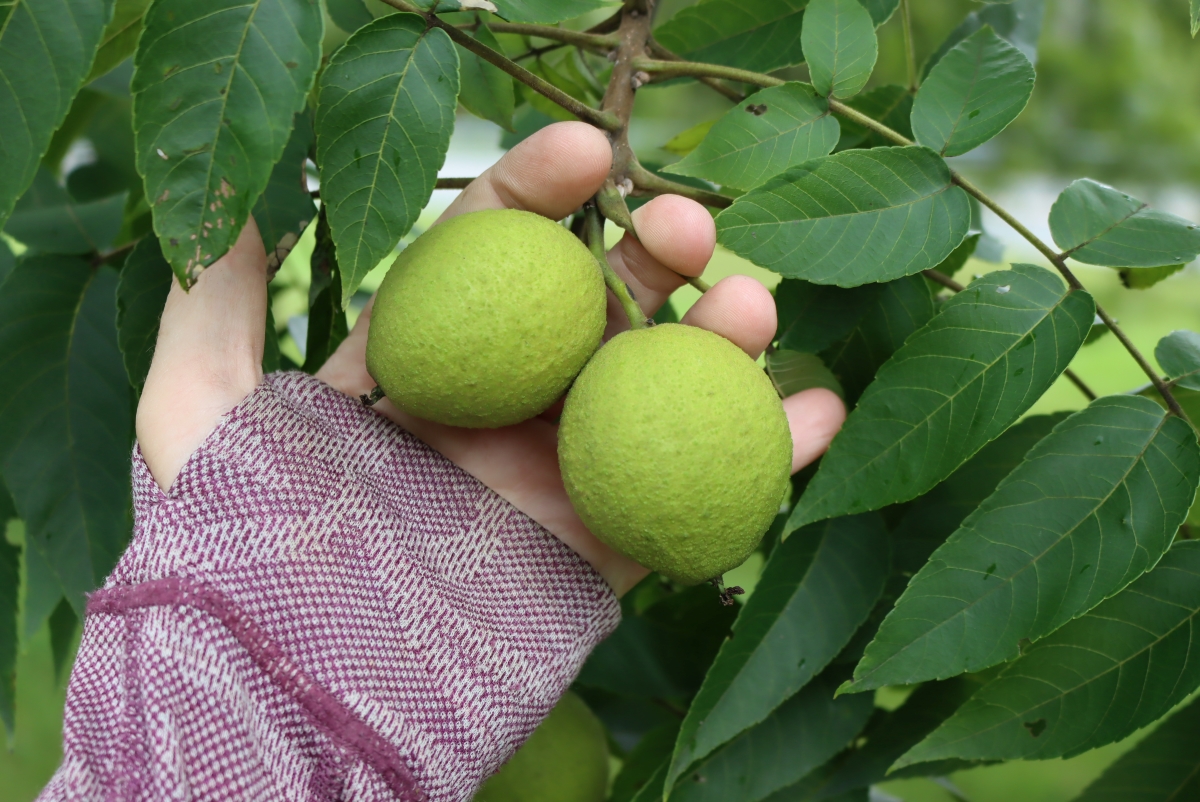
Black Walnut Tincture Uses
Herbalists use black walnut tincture both topically and internally to treat a variety of ailments.
Topically, black walnut tincture is used for:
- Treating Fungal Infections
- Treating Bacterial Infections
Internally, black walnut tincture is used to:
- Treat Bacterial Infections
- Treat Fungal Infections
- Treat Diarrhea and Other Digestive Disorders
- Kill Specific Parasites
Additionally, the herb is currently being investigated for its potential:
- Treat Hypothyroidism
In these cases, research is ongoing, and more work is needed to establish whether or not the benefits are scientifically significant.
If you don’t happen to have black walnut trees nearby, or they’re not currently in season, black walnut tincture is available from Starwest Botanicals. They also sell black walnut hull capsules in easy pill form or dried black walnut hull powder for use in topical antifungal remedies (such as salves and creams).
Black Walnuts and Iodine
Not only is black walnut tincture a potent medicine, it’s also one of the few land-based sources of iodine. While you can forage for salt deposits inland or extract salt from plant material when you’re far from ocean salt sources, most inland sources of salt lack iodine. Black walnuts, specifically black walnut husks, are a great source of iodine in a pinch.
I’ve found spotty references suggesting that black walnut hull extracts were applied to those exposed to radiation after the Chernobyl disaster. Supposedly, if you apply the black walnut tincture to the skin, the iodine can be absorbed directly. I’m still looking for a good, reputable source to back up this information.
Other sources say it contains enough iodine to be used as a topical wound anesthetic. Given that black walnut tincture also contains tannins, which are antibacterial, this makes sense even if iodine levels are, in fact, relatively low. Add in the fact that it’s in a suspension of high-proof alcohol, and you’ve got a great recipe for wound sterilization.
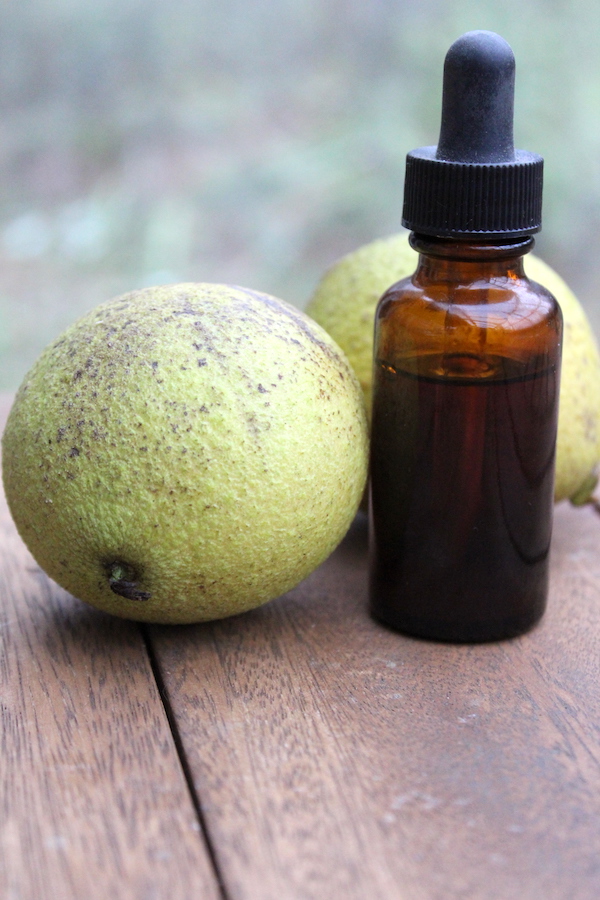
Benefits of Black Walnut Tincture
In traditional medicine, black walnut tincture has been used internally and topically. Native Americans harnessed the healing powers of black walnut to treat goiter, smallpox, sores, hemorrhoids, parasites, and fungal infections like ringworm and athlete’s foot. Colonists adopted the use of black walnut as an antiparasitic.
Herbalists continue to use black walnut in many of these same ways today. Two contemporary herbalists, Phyllis Light, and Matthew Wood, continue to recommend black walnut for the treatment of goiter and hypothyroidism.
Modern research has indicated that black walnut hulls are an incredibly powerful yet safe herbal remedy. The hull extract has shown antibacterial activity against common bacteria like E. coli, B. subtilis, P. aeruginosa, and S. aureus. These bacteria commonly cause UTIs, gastrointestinal infections, staph infections, pneumonia, sepsis, and endocarditis, particularly in immune-compromised patients.
The hulls have also demonstrated antifungal activity against several fungi. One particular fungus it’s effective against is A. terreus, which commonly causes infections in immune-compromised patients and is resistant to amphotericin B, a common antifungal drug. It’s also effective against one of the most common food-contaminating fungi, A. ochraceus, and another fungus. A. brasiliensis, which can cause lung infections.
One of the most common ways herbalists use walnut hulls is to expel worms and other parasites. Unfortunately, little research has been done to verify this usage. However, a few studies have shown that juglone, one of the main active compounds in black walnut, may have some antiparasitic properties.
One 2015 study found that juglone helped induce cell death in Acanthamoeba, a relatively common ameba (single-celled living organism) that can cause rare but severe illness, infecting the eye, brain and spinal cord, or entire body. Another 2020 study found that juglone derivatives were highly effective against Trypanossoma cruzi, a parasitic protozoan that causes Chagas disease (American trypanosomiasis).
Though there is little research to support black walnut’s use in treating goiter and hypothyroidism, there may be a reason behind the anecdotal evidence. Black walnut hulls are high in certain minerals like iodine and magnesium. Iodine deficiency is one of the common causes of hypothyroidism. However, hypothyroidism can also be a symptom of serious diseases like cancer, so it’s best to consult your physician before treating it.
Another component of black walnut hulls, tannins, may play a role in this remedy’s use for digestive issues. Plant tannins are believed to be an effective way to shorten the duration of diarrhea. Tannin-rich plants have also long been used in herbal medicine to treat gastric ulcers and other gastric disorders.
Black walnut tincture is considered fairly safe, but you should still use some caution. Anyone with a nut allergy should avoid using black walnut hull tincture. Prolonged topical or internal use isn’t recommended. Black walnut hulls contain stong compounds like juglone, and their longterm effects are well understood.
Topical use of black walnut hulls may temporarily dye the skin. Some people may also find it irritating, so it’s best to start with a small patch of skin.
Generally, herbalists recommend taking 1 to 2 droppers full of black walnut tincture three times per day and using it topically as needed. However, you should consult with a clinical herbalist for specific dosing instructions, as the dosage varies with the intended use.
Parts Used for Tincture
There are many useful parts of the black walnut tree, but for this tincture, we want to collect the green hull or husk on the walnut. Most black walnut trees are too tall to pick from, so you’ll have to wait until the nuts fall in late summer or fall.
Collect the nuts from the ground while the husks are still as green as possible. Give them a good rinse if any are dirty.
There are many ways to hull black walnuts, but most of these methods focus on destroying the hull in order to harvest the nut inside. We want the hulls to be in good, clean shape, so it’s best just to cut the hull off using a knife. While this may seem a bit tedious, the hulls are rather large so we can quickly get the amount we need for a tincture.
As you first cut a very fresh black walnut it can be a bit deceiving. The fresh husks are a creamy white color. As they’re broken and exposed to air, they oxidize almost immediately and begin to turn brown. I was hoping to get a picture of the white interior, but they brown in less than 2 seconds and I just couldn’t move that fast.
Once you’ve sliced the soft green husk from the outside of the black walnut shells, place the hunks of black walnut hull in a jar. Pick a jar that you don’t mind losing because the tincture will stain the glass and it will not wash off. Fill the jar to within about 2 inches of the top with black walnut husks.
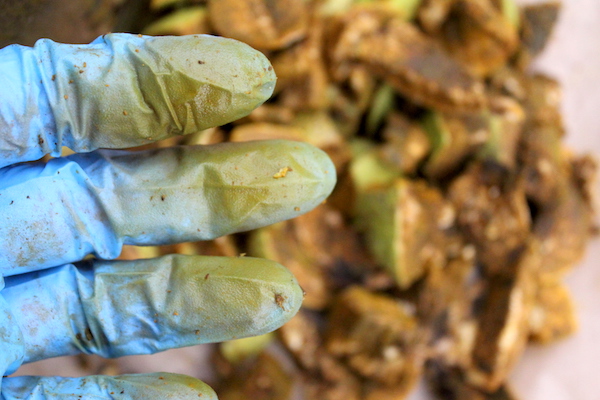
If you care about your hands’ appearance or have sensitive skin, always wear gloves while handling black walnut hulls. The hulls contain a powerful dye that quickly stains hands. It can take weeks for the stains to completely disappear.
If you don’t have any black walnut trees growing near you, you can order ingredients online. Mountain Rose Herbs carries black walnut hull powder you can use to make a tincture.
How to Make Black Walnut Tincture
To make a black walnut tincture, you’ll need the following ingredients and equipment:
- Green Black Walnut Hulls or Dried Black Walnut Hulls
- Vodka* (or any other palatable alcohol that’s at least 80 proof/40 percent – whatever you have on hand is fine)**
- One-pint mason jar with lid (amber glass is ideal, but as long as you keep the tincture away from light at all times, it won’t make a difference)
- Funnel
- Cheesecloth
- Fine mesh sieve
- Amber glass tincture bottles (with dropper)
*The Herbal Academy’s tincture-making course specifically recommends using 70 to 95% alcohol for fresh herbs.
**Never use isopropyl/rubbing alcohol for tinctures (or any other remedy you plan on ingesting). Even in small amounts, this type of alcohol is toxic and meant for external applications only.
To make the tincture, add fill a jar about 3/4 of the way full of fresh green black walnut hulls or about halfway full with dried black walnut hulls.
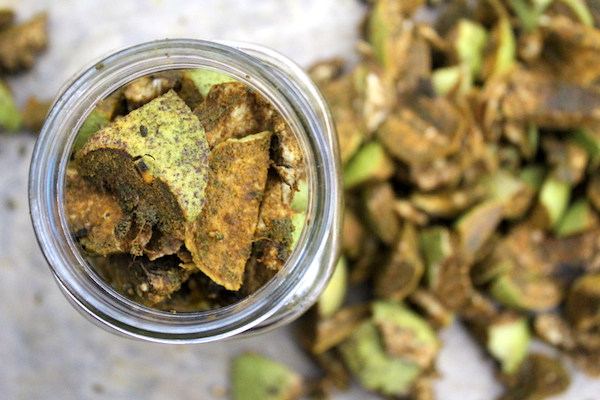
Once the jar is nearly full, fill it to the top with alcohol, making sure the hulls are fully submerged.
Place a clean, airtight lid onto the jar and set it in a cool, dark place. Always keep it out of direct sunlight.
Store your developing tincture for 4 to 6 weeks, taking it out once a day to give it a gentle shake. Don’t worry if you miss a day or two. Tinctures are very forgiving.
Give the jar a shake every time you think about it, but be extra sure the lid is on tight. If it’s not, that’s one unholy staining mess that’s much worse than your average homemade tincture.
After about 4 to 6 weeks, the alcohol should be a dark brown or almost black color. Then, it’s time to decant your tincture.
Take your fine mesh sieve or line your funnel with cheesecloth and strain the tincture in brown glass tincture bottles. Squeeze the hulls to get all of the liquid out.
Once you’ve bottled your tincture, label all the bottles with the name, date, and dosage. I find that masking tape and markers work well for this. The tape is easy to peel off later so that I can re-use the bottles.
Black Walnut Tincture Dosage
Consult a clinical herbalist for an exact dosage specific to your body and needs.
Though black walnut tincture is considered a gentler way to purge parasites than conventional prescription de-wormers, it’s still hard on the system. There is some evidence that it can cause mouth or throat cancer if taken internally over long periods. Do not use black walnut tincture for more than 2 weeks at a time.
Most clinical herbalists say the the dosage for black walnut tincture is usually 15-20 drops taken in water 2-3 times per day. One dropperful is around 20 drops. (Some guides say 1 to 2 droppers full, taken 2 to 3 times a day, so dosages do vary. If you want something specific you, you’d need to talk to a clinical herbalist about your specific concerns).
You can also use it topically as needed.
Black Walnut Formulations
Herbalists sometimes combine black walnut tincture with wormwood, another powerful antiparasitic digestive herb. I also recommend using it in combination with ginger for stomach upset.
If you’re using black walnut to treat and fight internal fungal or bacterial infections, I recommend pairing it with immune-boosting herbs. Good options include elderberry, echinacea, or self heal.
For external use, you can combine black walnut’s antifungal and antibacterial properties with other antifungal herbs like oregano or herbs that help soothe skin irritation, like calendula.
Black Walnut Powder
Besides a black walnut tincture, the green hulls can also be dried to make a black walnut powder. The powder is a bit more versatile since it can be mixed with water to make it into an ink, dye, or wood stain. A black walnut powder can also be used for medicinal purposes just like a tincture (but without the alcohol).
I’ve also seen it made into a salve for topical antifungal use.
I covered a baking tray with black walnut husks and placed them in the oven at 300 degrees for 3-4 hours. They didn’t feel that wet in my hands when I put them on the tray, but they took a surprisingly long time to dry in the oven.
I would not suggest trying to air or sun-dry black walnut hulls. They degrade and spoil quickly, and will liquefy within a day or two of cutting. Get them into an oven or near a woodstove quickly to dry.
Once they’re fully dry, allow the black walnut husks to cool completely. At this point, they can be ground into a powder with a food processor or small coffee grinder. Be careful not to use anything that cant be stained, as the powder will stain the plastic of a food processor quickly.
Out of season, you can also purchase dried black walnut hull powder, which is rather inexpensive given that the hulls are commonly considered a waste product of nut production.
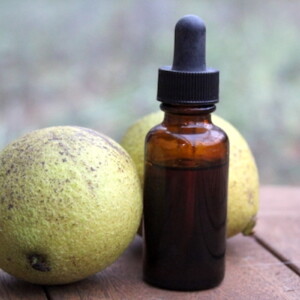
Black Walnut Tincture
Equipment
- Optional: Gloves (the walnut hulls can stain your hands)
Ingredients
- Fresh green walnut hulls enough to fill about 1/2 to 3/4 of your jar
- High-proof alcohol such as vodka, rum, or brandy—at least 60 proof or 30% ABV
Instructions
- For this tincture, you’ll need the green outer husks of fresh black walnuts. When gathering, be sure to wear gloves to avoid staining your hands. You’ll want the hulls to be green and unripe, ideally gathered in late summer or early fall when they are fresh and intact. Use a sharp knife to carefully remove the husks from the nuts. If the nuts are still attached, simply slice open the husk to access the green outer layer.
- Once you’ve collected your hulls, chop them into smaller pieces to help with extraction. Fill a clean mason jar about halfway with the chopped green walnut hulls (fresh is best for potency). You can adjust the amount based on how much tincture you want to make. The hulls should fill about 1/2 to 3/4 of the jar, leaving room for the alcohol.
- Pour your high-proof alcohol over the green walnut hulls, ensuring they are completely submerged. Use enough alcohol to cover the plant material by at least an inch or more. If necessary, add more alcohol to keep the hulls submerged throughout the extraction process.
- Tightly screw the lid onto the jar and give it a gentle shake to mix the contents. Store the jar in a cool, dry place away from direct sunlight for the next 4 to 6 weeks. The tincture will need time to extract the medicinal properties from the walnut hulls.
- Every couple of days, shake the jar gently to ensure the walnut hulls stay mixed with the alcohol and remain submerged. Fresh plant material, especially something fibrous like walnut hulls, may try to float. Keep the hulls pressed down or add more alcohol if necessary to keep them fully covered.
- After 4 to 6 weeks, it’s time to strain the tincture. Place a fine mesh strainer or cheesecloth in a funnel and position it over a clean dark glass bottle. Pour the tincture through the strainer, pressing the walnut hulls to extract all the liquid. Discard the spent plant material, as its job is now done.
- Label your tincture bottle with the contents, date of preparation, and any important usage instructions. Store the tincture in a cool, dark place, away from heat and sunlight. Black walnut tincture can last for several years if stored properly.
Notes
Internal Use
Black walnut hull tincture is commonly used internally for parasite cleansing and as an iodine supplement. The recommended dosage can vary, but generally, it’s taken in small amounts. Most clinical herbalists say the the dosage for black walnut tincture is usually 15-20 drops taken in water 2-3 times per day. One dropperful is around 20 drops. (Some guides say 1 to 2 droppers full, taken 2 to 3 times a day, so dosages do vary. If you want something specific you, you’d need to talk to a clinical herbalist about your specific concerns). Be cautious with dosage, as black walnut hull can be potent.External Use
Externally, this tincture can be applied to wounds, skin conditions, or used to help with topical iodine supplementation. For topical use, simply apply a small amount to a cotton ball and gently dab it on the affected area.Safety Note
While black walnut tincture is a powerful remedy, it should be used with care, particularly for internal use. It may not be suitable for everyone, and excessive use can cause side effects. Always consult with a healthcare provider before using it, especially if you are pregnant, nursing, or have existing health conditions.Alcohol-Free Glycerite Option
If you prefer an alcohol-free tincture, you can create a glycerite using vegetable glycerin. To make a black walnut glycerite, fill your jar with dried black walnut hulls and cover them with a mixture of 3 parts glycerin to 1 part water. Shake daily for 4 to 6 weeks, then strain as you would for an alcohol-based tincture. This glycerite can be used in the same way as the alcohol tincture for internal and external applications.Yield
The final yield of tincture will vary depending on how tightly you pack your jar and the type of plant material used. Expect to get about the same amount of tincture as the alcohol you initially add if using fresh black walnut hulls. Dried hulls may absorb some of the alcohol, so you’ll likely end up with slightly less than the alcohol you started with. Typically, for a quart jar, you will need about 2-3 cups of alcohol, and for a pint jar, about 1 to 1.5 cups. Be sure to keep the walnut hulls submerged at all times to ensure the extraction process is as effective as possible.Tincture Recipes
Looking for more easy-to-make herbal tincture recipes?
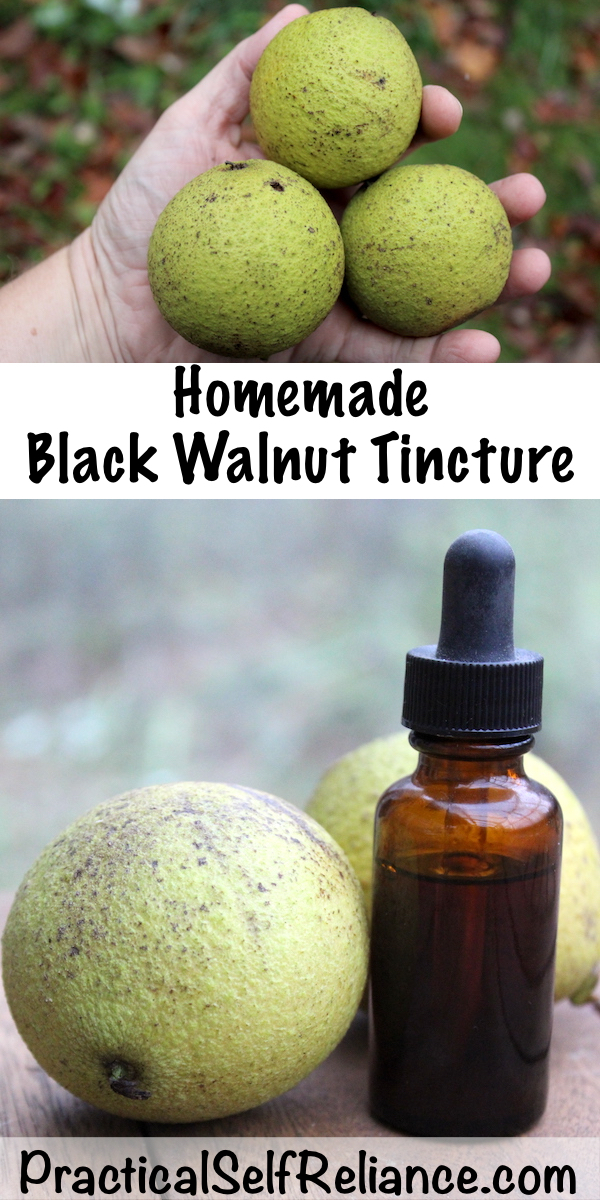
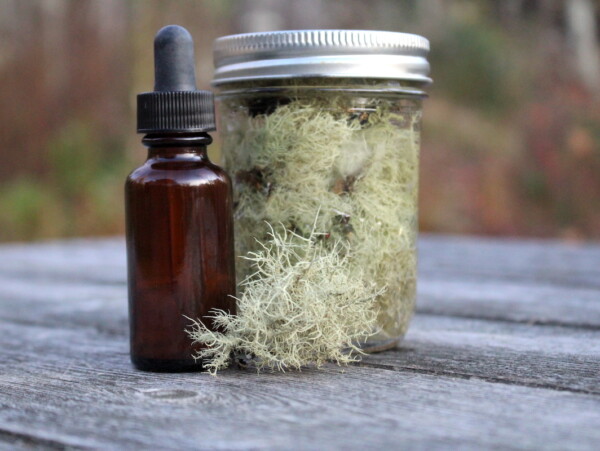
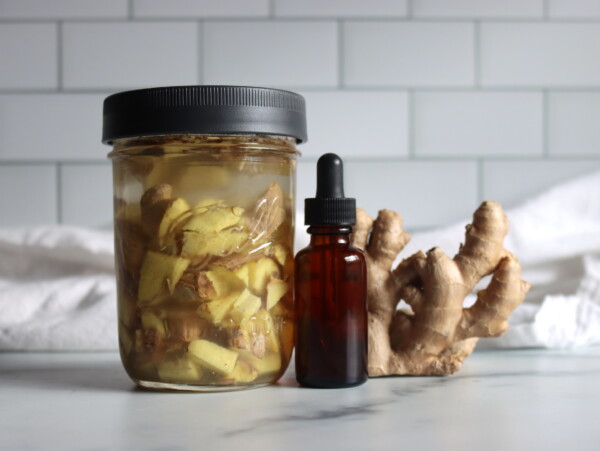
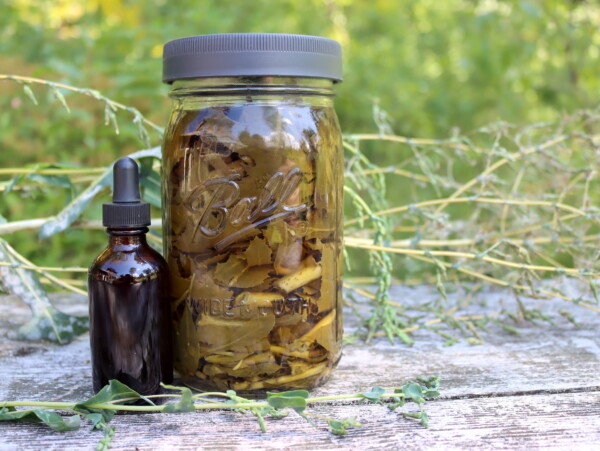
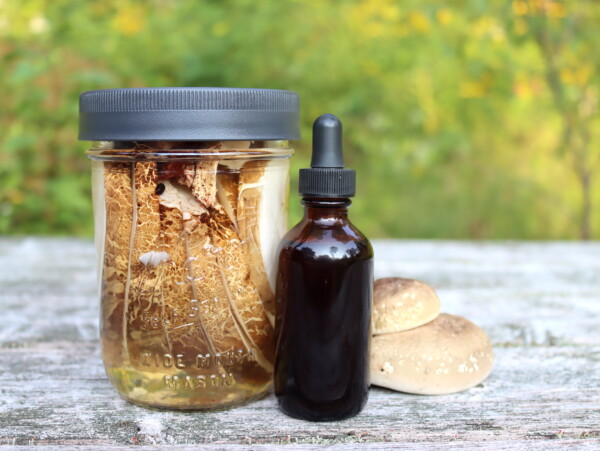
Thank you for what you do.
You’re quite welcome!
At the top of the article it states that normal dosage is 15 -20 drops in a glass of water 2-3 times a day than lower down after the recipe is states to use 1-2 drops. That’s quite the difference, other articles I’ve seen are in that 15 -20 drop range as well. Maybe I should go with mid range.
That’s a type-o further down, it should say 1-2 droppers full. I’ve now changed both places to this, for clarity:
Most clinical herbalists say the the dosage for black walnut tincture is usually 15-20 drops taken in water 2-3 times per day. One dropperful is around 20 drops. (Some guides say 1 to 2 droppers full, taken 2 to 3 times a day, so dosages do vary. If you want something specific you, you’d need to talk to a clinical herbalist about your specific concerns).
We do this different way but it is very effective!
Can you make a tincture with walnut powder instead of hulls?
Yes, the black walnut powder is made from the hulls.
Can you use ACV in the black walnut tincture for deworming pets ?
Are you wanting to know if you can make the tincture without alcohol and use vinegar instead?
Hi! Love your blog!
Just read through all the comments. Can I get some tips on using the tincture externally, like to treat wounds?
If you’re using a tincture externally to treat wounds, I would dilute it with a little water so that it doesn’t burn. You want to do some research and choose an herb that will specifically address whatever issue you’re trying to address.
Even if you’ve never noticed the it’s when the bill is green on the tree,after a couple of years of missing harvesting the hills while still green,you learn to look for them. I don’t have any trees in my yard but they grow everywhere here in Tennessee. Not hard to find them on public or vacant property.i just asked someone if I could pull from his tree and he was happy to oblige. Amazing hosu many people look at black walnut as a nuisance and not food.
I had black walnut powder, I thought it was spoiled and poured it into a bucket which contained a solution with washing powder. The solution turned blue.
There was probably a lot of iodine in there, but I’m not sure.
Why did you think it was spoiled? The powder shouldn’t really spoil as long as it is properly dried. It might lose some of its potency but not spoil.
Hi I’m in the process of utilizing the black walnuts that have fallen this year and I was wondering if there’s a stage where the hulls are no longer good to use before the slimy black stage? A lot of the ones I have are a yellowish green, with black spots on them since the trees are way too tall to climb and I didn’t realize what they were until I went down my driveway to double check. To much my surprise they were what I thought they were so I picked up the ones that still had as much of the color to the hull as possible. I cut into those and got the nut out and scraped some of the darker pulpy stuff out of the hulls that had bugs in it
(most of the nuts had a dark pulp around them, some of which had bugs, are these still ok to use?) This is my first time doing this and I just want to make sure that I’m doing it right. I live in east TN and there’s so much going on as far as herbal and medicinal plants that grow around here. I’m trying to learn as much as possible. Anyway. Thank you. I appreciate it.
If you’re going to take the time to process the black walnuts for medicine, I would suggest getting them as fresh as possible so that you get the most benefit from them.
I can attest to the anti-parasitic properties of black walnuts. After getting the hulls off the nuts I washed them in a bucket of water to get rid of the “floaters”. I poured the rinse water out of the bucket and as SOON as the rinse water hit the ground, there were hundreds of earthworms coming out of the ground! The strong tannins in the water really messed with them and they wanted away from it. I ended up rescuing hundreds of earthworms by hand and moving them away from the walnut water area! An unintended experiment. Next time – find a different spot to rinse the nuts!
My mother always made black walnut tincture with the whole nut and green husk. She picked them when the nut was soft enough to cut into quarters, covered with vodka and soaked for 6 weeks. Strained and placed liquidated in new container. Covered the walnuts with equal amount of water to soak for another 2 weeks. (Shake daily)
Strain and combine the two batches. I store this tincture in small dark glass brandy bottles.
Thanks for the info. Can you pick the black walnuts from the tree for use? When they fall by me they brown quickly or split and get filled with bugs!
As long as they are fully ripe, it’s fine.
Thanks for the reply. I am a few hours south of you in Northern New Jersey. How can I gage when they are ripe?
You will notice the leaves starting to turn as they ripen. The leaves go from a deep green to a bright yellow. When you apply gentle pressure to the husks they should give a little under the pressure.
Hello. I have some black walnut hulls that I’ve already been dried little pieces, I bought them from an apothecary shop. Can I make a tincture out of those?
Yes you can.
you said you were still looking for a good source regarding black walnut for iodine…Here you are: And THANK you for the info on making the powder from the hulls!
https://www.naturalnews.com › 032028_iodine_black_walnuts.html
Iodine in black walnut tincture may be effective against radiation …
Black Walnut Tincture Is a Safe and Effective Source For Iodine Black walnut tincture is not only high in a bio-assimilable, plant form of iodide, but it also has anti-bacterial, anti-parasitic, and fungicidal properties. The amount of iodine in black walnut tincture is so high that it can be used as a substitute for iodine antiseptics.
Thank you so much for sharing that information. We really appreciate it.
Small fresh black walnuts, very green fallen on the ground. I cut into one wondering how hard it was going to be to get just the hull. The whole thing sliced rather easily. I’m wondering if it’s okay to put the quartered black walnuts in without removing the insides for tincture. Do the insides have to be removed?
I would stick with just using the hulls. I have never heard of anyone using this method.
I love making nocino with black walnuts. Cut the whole thing in half, fill a large jar, add in aromatic whole herbs and spices like clove, cinnamon sticks, cardamom pods, star anise, vanilla bean, citrus rind, bay leaf…..then pour vodka over it until full. Cap and let sit for a month or more. The strain and bottle. I like drinking it with milk, tastes like a White Russian. Delish! Also makes a great apertif!.
Sounds great! Thanks for sharing.
Thanks for sharing! Does it keep long?
Yes, a tincture will keep for a very long time.
This looks so good! What a fun formula to make with kids too! They love finding black walnuts!
So glad you enjoyed the post.